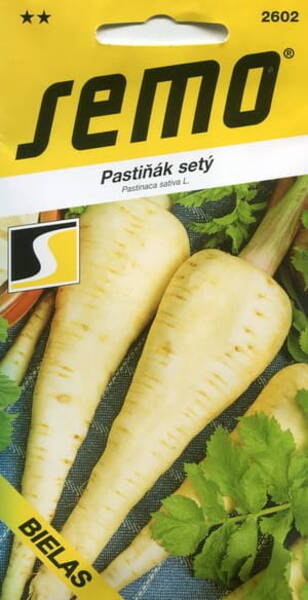Parsnip is a valuable dietary product.
Biennial spicy vegetable plant of the Apiaceae family. Up to 30 cm high. Cold-resistant, moisture- and photophilous, frost-resistant.
Grows well in humus-rich, neutral soils. Sow in early spring in well-lit areas. Seeding rate 0.4-0.5 g/m2.
Seeding depth 1.5-2 cm. Row spacing 20-30 cm. Seeds germinate in 3-4 weeks. Seedlings are thinned out, leaving 10-15 cm between plants.
Parsnip grows especially slowly for the first 2 months, therefore it requires careful care: loosening, weeding, watering is not frequent, but plentiful (10 litres of water per 1 m2).
NB! On hot days, parsnip leaves release burning essential oils that can cause skin burns, so it is best to take care of the crops early in the morning or late in the evening.
Root crops are harvested late in the fall, but before the onset of frost. Stored in the sand at high humidity and low temperature.
* There is no onion fly in the carrot bed next to the parsnips. Is this a coincidence or a pattern?
This phenomenon is not accidental, since the effect of parsnip phytoncide is manifested here.
Parsnip. Bot. syn.: Pastinaca fleischmannii Hladnik.
* Parsnip occupies one of the first places among root crops in terms of the content of easily digestible carbohydrates.
The pleasant taste and aroma are due to the presence of essential oil.
The root crop is rich in vitamins, especially C, B and B2, it contains sugar, protein, fat, pectin and mineral salts.
Since ancient times, parsnip has been well-known as an appetite stimulant and has a beneficial effect on digestion and the assimilation of other foods.
In folk medicine, root vegetables are used as a diuretic. Parsnip preparations have antispasmodic, analgesic and photosensitizing effects.
The powder obtained from seeds dilates blood vessels, improves blood supply to the heart muscle, and has a calming effect on the central nervous system.
In appearance, the plant looks like a large white carrot, and its sharp, peculiar taste resembles celery and parsley.
Root crops and seeds are used for medicinal purposes. The roots are harvested in autumn, shaken off the ground, dried and then stored in the basement in wooden boxes with dry sand.
When harvesting mature seeds, umbrellas are cut with stalks, threshed, dried and stored in a cloth bag for 2 years.
When harvesting parsnips, care must be taken, since the contact of wet skin with parsnips can lead to inflammation of the skin of the hands and the appearance of burns on the affected areas.
The reason for this is the presence of furocoumarins and substances that make up the essential oil. Skin lesions are noted only when exposed to sunlight and, as a rule, in blondes.
Parsnip preparations have antispasmodic, diuretic, analgesic and expectorant, as well as tonic and stimulating sexual function action.
Parsnip improves metabolism, has a slight hypoglycemic effect and has a positive effect on the course of diabetes.
Parsnip roots are used in home cooking and used as a seasoning in soups and as a side dish for meat.
A salad is prepared from grated parsnip roots mixed with chopped apples, chopped onions, green dill, salt and mayonnaise are added.
1. 1 teaspoon of crushed roots per 1 glass of water, boil over low heat for 10-12 minutes, strain and take 1 tablespoon 4-6 times a day as a diuretic, antispasmodic and analgesic for sand and stones in the kidneys and bladder, oedema, to alleviate cold cough and improve sputum separation.
2. 1-1/2 tablespoons of crushed leaves in 1 cup of water or 1/2 teaspoon of crushed fruit in 2 cups of water, boil for 10-12 minutes and strain. Take 1 tablespoon 4-6 times a day for the above diseases.
3. 2 tablespoons of crushed roots per 1 cup of boiling water, insist. Take with sugar or honey 1 / 4-1 / 3 cups of infusion 3-4 times a day 30-40 minutes before meals to improve appetite, as well as with a general loss of strength and during the recovery period after an illness, significantly weakening and exhausting organism.
4. Parsnip root juice. Take 1 teaspoon 3 times a day as above.












